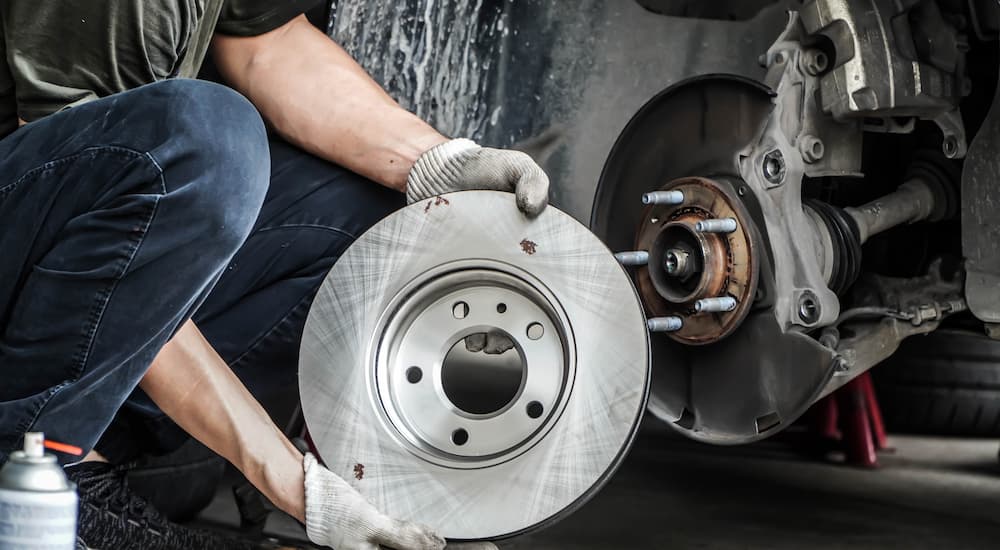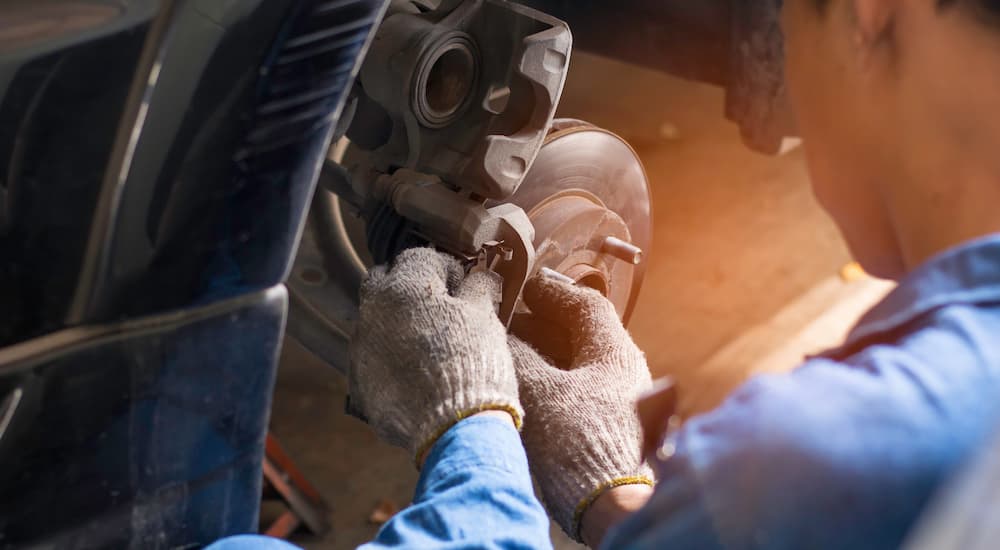While many of today’s vehicles include a bevy of advanced safety features, your Honda’s brakes are still the first line of defense when you’re behind the wheel. Of all the components in a vehicle, drivers tend to interact with their brakes more than most. This can lead to a lot of wear and tear but can also make it easier to tell when something has gone awry since you’ll be able to quickly develop a baseline for what normal operation feels like. Still, it can always be helpful to have a few hints when it comes to Honda brake maintenance. From lights and strange noises to brake feel and even smells, there is no shortage of ways to tell when your brakes are on their last legs. Let’s examine some of the most common indicators of failing brakes and give you a couple key signs to keep an eye out for.
Brake Light
The first and easiest sign of an issue with your brakes is an illuminated Brake System light on your vehicle’s dashboard. This is distinct from the Anti-Lock Brake System (ABS) warning light, which indicates an issue with the system that prevents the wheels from locking up when you slam on the brake pedal. The Brake System light, which also might simply read “Brake” depending on the model, points to an issue with the physical braking system itself. This light often merely means that the parking brake hasn’t been properly disengaged, though, in some instances, it can indicate low brake fluid or a larger problem within the braking system. Such problems might include a faulty pressure differential switch or, on some newer vehicles, a burnt-out brake light (that is to say, the actual red lights on the rear of the vehicle, not the dashboard Brake System light). Make sure the parking brake is fully disengaged, and if the light still doesn’t go off, take the vehicle in to be serviced. Brakes are one component that you particularly don’t want quitting mid-ride, so skip the DIY approach and call in the professionals.
Squealing/Squeaking
While many of the components in today’s vehicles are marvels of modern engineering, most brakes still rely on a surprisingly archaic principle in order to work. Strip away all the automotive jargon, and what you basically have are two pieces of material––the brake pads and brake rotors––scraping against each other, with the resulting friction responsible for slowing the vehicle down. Brake pads are actually made from a variety of different materials, including iron, steel, copper, ceramics, and organic resins. When these pads start to wear down, the rotors come in contact with particularly hard pieces of metal called the brake pad wear indicators. These hardened indicators don’t wear down like the rest of the pad and will make a distinctive high-pitched noise when pressed against the rotors, letting you know it’s time to replace the brake pads. Just make sure to visually inspect your brake pads before making an appointment to replace them, as this noise can also be caused by road debris like pebbles lodged in the pads.

Wobbling/Vibration
Brake rotors take a lot of abuse during everyday driving and are as prone to failure as any other component in your vehicle. When you press on the brake pedal, and the brake pads come in contact with the rotors, material is steadily worn away from the pads, with some of it transferring onto the rotors. If this material doesn’t transfer evenly, the rotors can develop irregular bumps and depressions, resulting in vibrations and wobbling when you engage the brakes. It’s a little bit like driving on a rutted dirt road––more driving isn’t going to even everything out; it’s going to make every bump and depression all the more pronounced, resulting in a rougher ride. If this issue is caught early enough, rotors can be reconditioned, with a technician smoothing out the surface to create a more even pattern of wear. In many cases, drivers simply opt to have the rotors replaced as this usually only needs to happen every 50,000 to 70,000 miles.
Fluid Leaks
Pressing your foot on the brake pedal doesn’t actually exert enough force to bring the vehicle to a stop; that’s where brake fluid comes in. Engaging the brake pedal moves a hydraulic piston and valve known as the master cylinder. This cylinder compresses the brake fluid, which uses hydraulic pressure to activate the calipers responsible for moving the brake pads into contact with the brake rotors. The force-multiplying properties of the brake fluid are what allow the braking system to operate, so having the correct amount of clean brake fluid is essential to safe driving––and stopping. Your vehicle has a number of ways of letting you know that it’s lacking brake fluid, from the aforementioned Brake System light to soft, unresponsive brakes, but brake fluid leaks are another good indication. If you notice light yellow or brown fluid beneath your vehicle, specifically under your brake lines, master cylinder, rotors, or drums, you’re likely dealing with a leak in the braking system. Brake fluid is oily to the touch, but the best indicator is the smell, as it typically has a fishy odor.
Spongy/Soft Brakes
As we mentioned above, soft or spongy brakes can indicate a lack of brake fluid, but that’s just one possibility. If the brake pedal doesn’t provide as much resistance as you’re used to––for example, if it can easily be pressed all the way to the floor with little in the way of actual braking power––then you could be dealing with air or moisture in the brake lines, or possibly an issue with the master cylinder. Since soft or spongy brakes can indicate a number of different issues, diagnosis is typically best left to the professionals. We’ve said it before, but another reminder couldn’t hurt: you don’t want to be taking any chances when it comes to your vehicle’s braking system.
Pulling to One Side
When you depress the brake pedal, the vehicle routes that braking power evenly to all four wheels, which should provide a nice, even stopping force. If your vehicle wants to pull to one side when you engage the brakes, it could indicate an issue with your brake hoses or calipers. If either of these two components is out of whack, it can prevent the brakes from engaging evenly, so when you step on the brakes, the vehicle will naturally pull towards the side with the working brakes. This phenomenon can be difficult to notice, especially if it’s only happening on one of the rear brakes, so regular brake inspection is a must. If you want to diagnose a potential issue on your own, try driving a short distance in your driveway or a closed parking lot. Remove your hands from the wheel before braking at low speed and watch to see if the wheel pulls in a particular direction when the brakes are engaged.

Burning Smell
A burning smell can mean a lot of things when it comes to your vehicle, and few of them are good. While it almost never actually means there’s something on fire, that burning smell can be a handy way of diagnosing a variety of automotive issues. When it comes to your braking system, a strong burning smell or sharp chemical odor can be a sign of overheated brakes. Best case scenario: you forgot to disengage the parking brake, and the fix is as easy as pulling a lever. Worst case scenario: your brake calipers are locked up, putting off smoke and refusing to do their job. In either scenario, you’ll want to pull off to the side of the road ASAP, check the parking brake, and do a quick visual inspection to confirm that the issue hasn’t ballooned into complete brake failure.
Pay Attention to Your Brakes!
There are plenty of early warning signs that you might be dealing with a brake problem, leaving drivers with little excuse when it comes to malfunctions. Develop a good baseline for what properly working brakes feel like, and you’ll have a much easier time telling when something isn’t quite right. Extending the life of your brakes is usually as easy as having a little patience. Try to avoid slamming on the brakes as much as possible, instead opting for a gradual application that will go a long way in reducing wear and tear. Try coasting whenever possible, letting the vehicle bring itself to a stop naturally instead of using the brakes. Keep your vehicle’s weight down and avoid hauling heavy loads, as the increased heft will lead to heavy wear. Lastly, avoid high speeds when possible, as the less force the brakes have to dissipate, the longer they’ll last. When in doubt, make an appointment with your local Honda dealership because when it comes to automotive safety, brakes play an outsized role.

